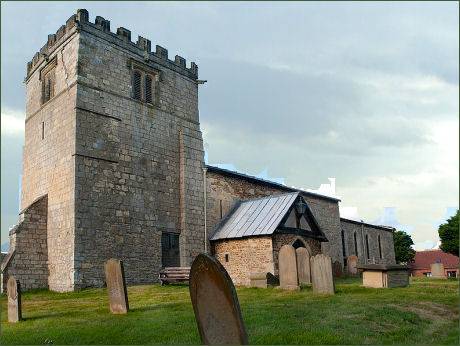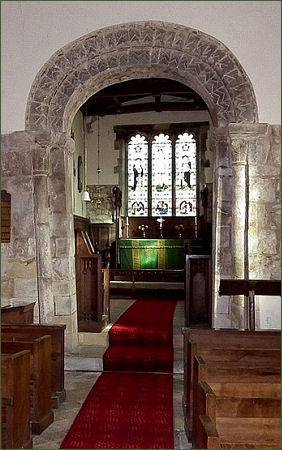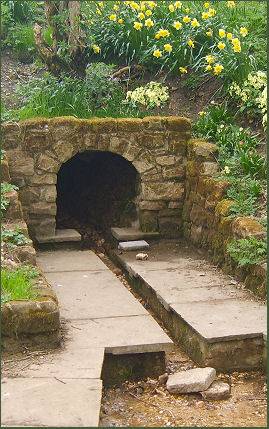Goodmanham
OS grid reference:-

 The pretty village of Goodmanham lies in the Yorkshire Wolds and is situated around 20 miles from the city of York.
The pretty village of Goodmanham lies in the Yorkshire Wolds and is situated around 20 miles from the city of York.
The village, once known as Godmundin Gaham, has a long and interesting history. There are a number of ancient burial sites in the area and the lines of ancient earthworks run along the edge of the village and provide evidence that it was once a prehistoric place of worship. Close to the western boundary of the village lies one of the most ancient roads of Britain, lwhich was later adopted by the Romans.
In Saxon times Goodmanham became the site of the high shrine of Anglo Saxon Northumbria, a great temple of Woden or Odin , the father of the Teutonic gods.
Edwin, King of Northumbria formed an alliance with the kingdom of Kent, and agreed to marry Ethelburga, daughter of the King of Kent. Ethelburga was a Christian princess, and only agreed to the marriage on condition that she be allowed to bring her priest, Paulinus to Northumbria.
After two years of marriage Edwin called a conference at Londesborough, only two miles from Goodmanham, and asked his advisors to debate whether he should convert his kingdom to Christianity. Paulinus put the Christian case forward and Coifi, Edwin's high priest, agreed to convert to the new religion. The conversion of King Edwin of Northumbria to Christianity brought about the overthrow of the temple in 627 AD by the high priest Coifi. The event is related the Venerable Bede in his 'History of the English Church and People'-
"I have known long since" (Coifi) said, "that there is nothing in this religion that we have professed...the more I sought the truth of it the less I found...this can give us life salvation and eternal happiness...I advise that we burn the useless sanctuary - and who better than myself as an example?" 'So saying, he borrowed a war stallion and a war axe, both of which were forbidden to him as a priest. He galloped to the temple and flung the weapon into the holy place. Seeing that no harm came to him, the company that followed him demolished the shrine and burned it to the ground.'
Coifi is said to have ridden the 20 miles from Edwin's council in York to destroy the temple at Goodmanham. Local tradition relates that the ride was from the king's summer camp at Londesborough, which is two miles from Goodmanham. A record of the village occurs in the Domesday Book of 1086.
The church of All Hallows now occupies the site of the original pagan temple to Woden. This building dates back to around 1130 AD and replaced an earlier wooden Anglo- Saxon church on the site. The handsome carved font dates to the sixteenth century. The previous font, which may date from the ninth century, was lost for many years until it was discovered in a farmyard, where it was being used as a drinking trough. That earlier font is now displayed near its Tudor replacement
A tumulus, located to the south-west of the village, is also supposed to contain ruins. The Goodmanham Arms pub (pictured left) in the village serves good home cooked food and real ales and has a vehicle museum which in addition to Harley Davidson motor cycles, contains a number of classic motor cars under restoration.
The village is situated on the Yorkshire Wolds Way National Trail, a long distance trail which runs for 79 miles from Hessle, East Yorkshire to Filey Brigg.
St Helen's Well
 St Helen's Well, of ancient origin, is situated on a slope to the east of Goodmanham, in a scenic wooded valley, just off the Wolds Way (OS Grid reference- SE 890 424). The well or natural spring was hidden for many years but has recently been restored.
St Helen's Well, of ancient origin, is situated on a slope to the east of Goodmanham, in a scenic wooded valley, just off the Wolds Way (OS Grid reference- SE 890 424). The well or natural spring was hidden for many years but has recently been restored.
The water rises from a natural grotto beneath an overhanging elder tree and fills a large triangular stone enclosure which is thought by some authorities to be a bath.
Little is known about the wells origins or whom the dedication is too. St. Helena, or Helen of Constantinople was the mother of the fourth Roman century Emperor Constantine the Great. Saint Helen of Caernarfon was a fourth century Welsh saint. Elen was the Celtic goddess of the ways, an antlered godess who presided over physical and spiritual pathways and paths that cross both nature and the human soul.
Above the well, different coloured strips of rag and cloth are tied to a tree. This ancient Celtic custom or folk practice, believed to restore good health involves the piece of rag being dipped upon the well's water, rubbed on an afflicted area and then hung on the tree. As this cloth rooted, it was believed the ailment would disappear.
A bench close to the well is inscribed with the verse -
'From dark to dark through fire-lit hall flies the axe that strikes the shrine
through burning that grows once more in stone and coloured light
through rain as it amazes chalk and flowers in this latest cup of breath.'
The well is reached by a short walk from the bridge in the village. Across the valley on its north side is an area that is full of mounds and ridges which is known locally as Howe Hills.
Towns and Villages of Yorkshire
